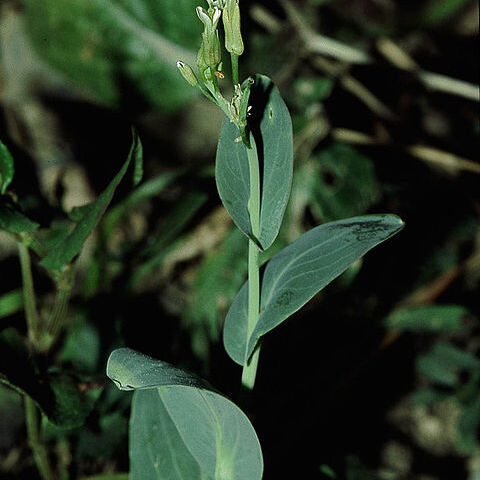Plants not scapose; (usually glaucous). Stems erect, unbranched or branched proximally. Leaves basal and cauline; subsessile or sessile; basal not rosulate, subsessile, blade margins usually entire; cauline blade (base cordate-amplexicaul or, rarely, auriculate), margins usually entire, rarely crenulate. Racemes (corymbose, several-flowered). Fruiting pedicels ascending, stout (almost as thick as fruit, or, rarely, much narrower). Flowers: sepals oblong; petals usually narrowly obovate, rarely oblanceolate, claw differentiated from blade [undifferentiated], (apex obtuse); stamens slightly tetradynamous; filaments not dilated, slender; anthers oblong (base slightly sagittate); nectar glands lateral, median glands often absent. Fruits sessile, linear, torulose, 4-angled or terete; valves each with prominent midvein; replum rounded; septum complete; stigmas capitate-flattened, entire. Seeds not winged, oblong [ellipsoid]; seed coat (papillose), copiously mucilaginous (granular) when wetted; cotyledons incumbent. x = 7 [9].
Sep erect, saccate at base; pet long-clawed, bright yellow to nearly white; short stamens subtended by a U-shaped gland; ovary cylindric, gradually tapering to the short style; ovules many; stigma capitate; fr elongate, slender, many-seeded, terete or 4-angled, tapering to a short beak; seeds in 1 row in each locule, oblong, granular-roughened; annual or biennial glabrous herbs, often glaucous; lvs entire, at least the upper cordate-clasping. 6, w. Eurasia, Mediterranean.
Annual herbs, glabrous. Sepals erect, dimorphic, the medians saccate. Petals long-clawed. Stamens 6. Nectariferous glands 2 or 4, usually crescent-shaped outside base of short stamens, median glands absent. Siliqua dehiscent, angled, beaked; valves with prominent midrib. Seeds in 1 row per locule. Cotyledons sub-conduplicate; radicle incumbent.

